Biorama 2: Inside the Hollow Earth
Posted in: Uncategorized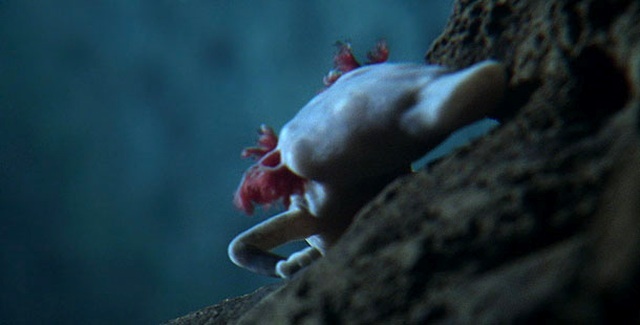

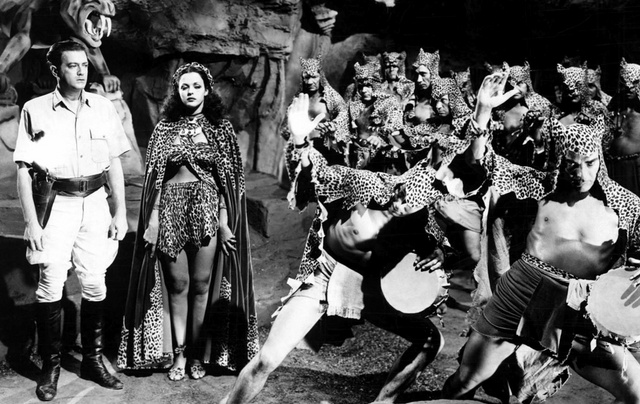
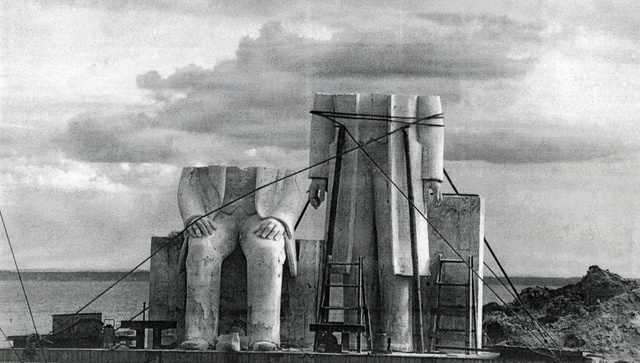

Concentrating on the modern era, the exhibition ‘War and Medicine’ considered the constantly evolving relationship between warfare and medicine, beginning with the disasters of the Crimean War and continuing through to today’s conflicts in Afghanistan and Iraq continue
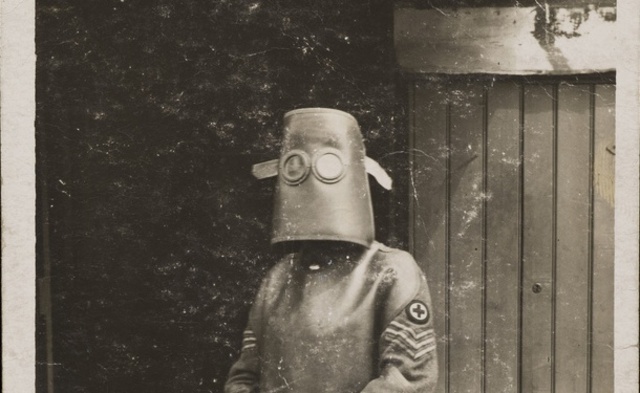
There’s so much more i’d like to write regarding the PHotoEspaña festival which runs in Madrid until July 28. Time has come to cover other exhibitions and artistic events i’ve visited more recently. However, i can’t turn the page without mentioning this little fellow playing as ghetto policeman. Almost every mainstream Spanish newspaper selected this image among those offered by the press kit to illustrate their coverage of the festival.
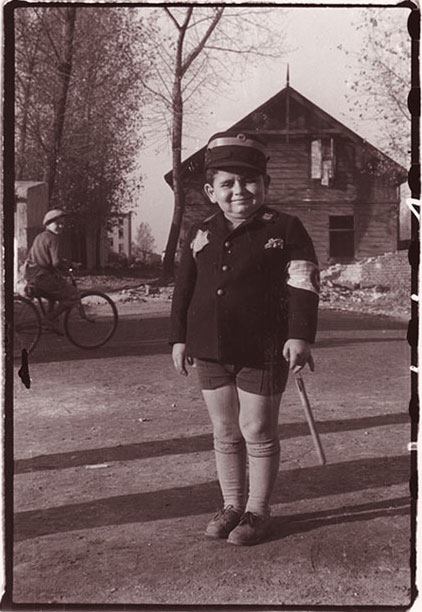
The portrait was made by Henryk Ross, a Polish Jewish photographer who was employed by the Department of Statistics for the Jewish Council within the Lodz ghetto during the Holocaust. Ross documented everyday life in the ghetto while staying officially in the good graces of the German occupier. Before the closure of the ghetto in 1944, Ross buried his negatives in the hope to leave a record of the martyrdom.
The Centro Andaluz de Arte Contemporaneo in Sevilla is currently running an exhibition dedicated to Ant Farm, a group of experimental architects and critical artists active mostly in the ’70s. The exhibition includes videos, models, original drawings, inflatables and all the quiet you can expect in a cultural center located inside a stunning monastry on the bank of the Guadalquivir River, the Monasterio de la Cartuja de Santa MarÃa de Las Cuevas.
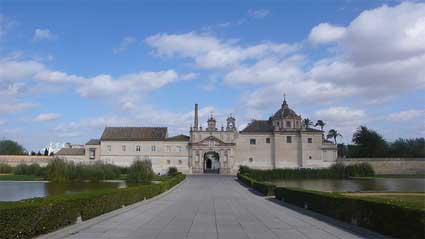
Monasterio de la Cartuja de Santa MarÃa de Las Cuevas
Founded in San Francisco in 1969 Ant Farm could be regarded today as a very effective mix between Archigram, the Rolling Stones and The Yes Men. Ant Farm embraced the latest technologies at the same time as they hit American culture on the head with their social and political comments and their highly critical (up to being in some cases destructive) approach to mass media. Their projects do not stop at the work of art itself, they also encompass the mass media rendering of that work of art.
All i knew about them was their rusty Cadillac Ranch installation which i do not like very much but the rest of their practice impressed me beyond words. I can’t think of any artistic group playing a similarly brilliant, innovative and multidisciplinary work today. Here’s a shortcut to their works:
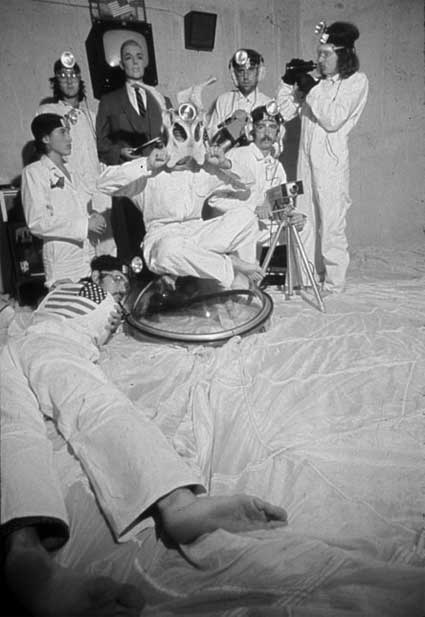
Ant Farm, Space Cowboy Meets Plastic Businessman, 1969. Performance at Alley Theater, Houston
Ant Farm deployed their conceptual world through videos, manifestos, spectacular performances and installations until 1978, when they disbanded following a studio fire. Most of the slide and video documentation was saved, but very little else survived.
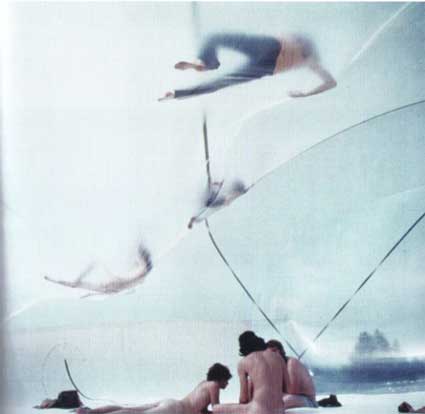
50×50 Foot Pillow, used as a medical pavilion at the Rolling Stones free concert at Altamont in 1969
Ant Farm started their career as evangelists of inflatable structures. Cheap and easy to assemble, they challenged the American consumerism culture and fitted perfectly a nomadic, communal lifestyle, in total contrast with the Brutalist architecture prevalent in the United States during the 1960s.
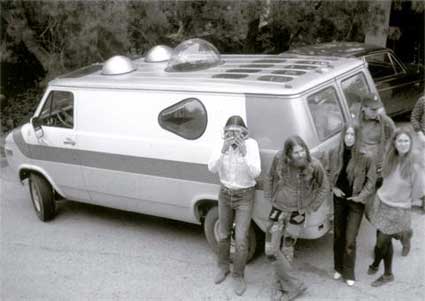
In 1971, they took the road abroad their Media Van, a customised Chevrolet van turned into a mobile studio to share information and images with the public while they toured the country to give talks and organize public happenings. The van not only transported the material necessary to build their ICE 9 inflatables but its motor was also used to generate the energy indispensable to blow up the structure.
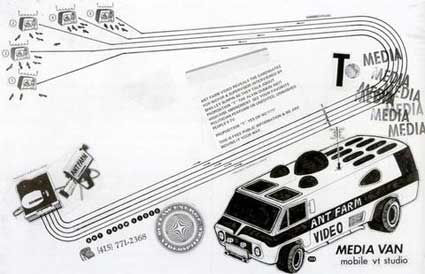
In 1972 the group built in Texas the House of the Century, a ferro-cement weekend residence with organic shapes that remind the inflatable structure that Ant Farm had realized a few years earlier, in particular their ICE 9 prototype.
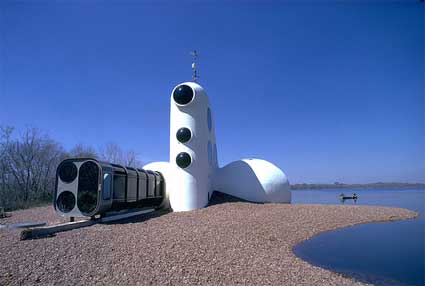
House of the Century, 1972
Video showing what the House was like before its decay:
The Dolphin Embassy was a never realized sea station in Australia which engaged with interspecies communication using the new video technologies. The structure would sail with the help of a solar mechanism.
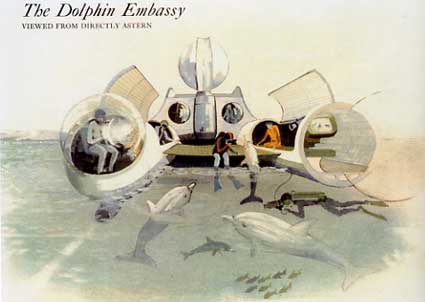
In 1974, Ant Farm created their most famous pieces in Amarillo, Texas, Cadillac Ranch. They half-buried a row of used and junk Cadillac automobiles dating from 1949 to 1963, nose-first in the ground, at an angle corresponding to that of the Great Pyramid of Giza. To add to the outrage done to the iconic vehicle, the public is very welcome to graffiti the cars.

Image wikipedia
The installation was originally located in a wheat field, but was later moved 3 kilometers to the west, to a cow pasture in order to place it further from the limits of the growing city.
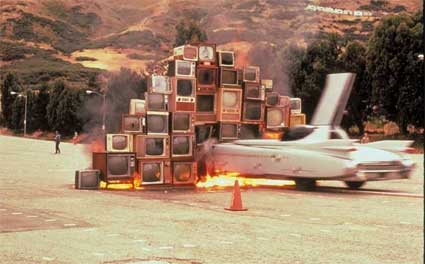
A year later Ant Farm staged the performance Media Burn. Dressed as astronauts, they drove at full speed a 1959 Cadillac into a wall of burning television sets. Media Burn critiqued American ideals of heroics and technological superiority, and offered an affront to the television media who were the only one invited to attend the event.
Their video of the performance is styled after news coverage of a space launch, including melodramatic pre-stunt interviews with the artists and a speech by “JFK” (impersonated by Doug Hall).

Short video and a 26 minute one.
Media Burn was not their first attack of the media, in 1972 they collaborated with the video collective Raindance to launch the guerrilla Top Value Television (TVTV) to provide alternative coverage of the political conventions of that year.
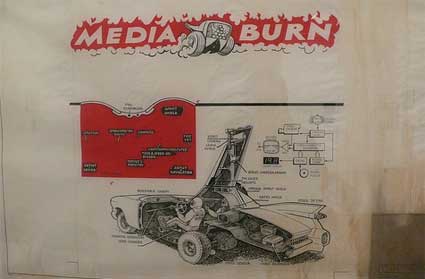
Let’s close the post with The Eternal Frame, a 1975 reenactment of the John F. Kennedy assassination. Part of it plays on America’s obsession with the media, but the video demonstrates also that the sacred images of the assassination cannot be mocked. The work can be read as a commentary on the pervasive media culture in America, as it explores how the Kennedy assassination itself became a new type of media event.
Video:
More images.
The exhibition of Ant Farm’s work is on view at the CAAC in Sevilla, Spain, until June 8, 2008.
Actar has just released Ant Farm – Living Archive 7. Felicity D. Scott has collected archival material to illustrate the early trajectory of the collective, including its architecture, inflatables, performance, multimedia, and video work.
Found on the flickr sets for unofficial ‘favorite photos’ of the staff of the Otis Historical Archives of the National Museum of Health and Medicine, in Washington DC: set 1, 2 and 3.
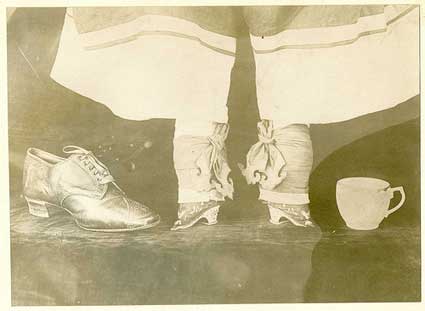
Orthopedics; feet of Chinese woman, bound, compared with tea cup and American woman’s shoe. World War 1 era
See also: Four x-ray views of footbinding, ca. 1948

Rhinoplasty. Loss of nose due to an injury, and replacement by a finger in 1880. Surgery by Dr. E. Hart, photo by OG Mason, both of Bellevue Hospital, NY
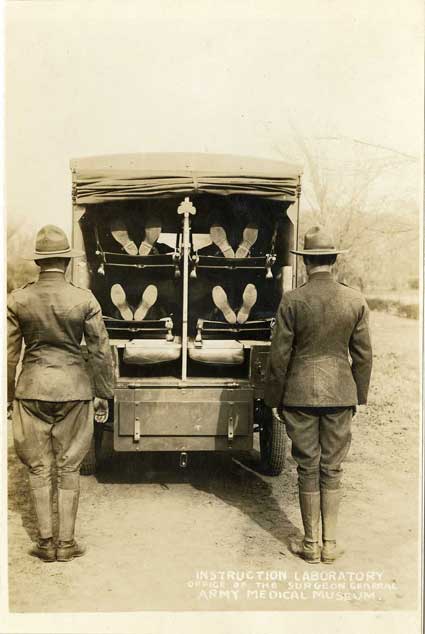
Ambulance drill. Four litters loaded. World War 1
On the homepage: Masks worn during experiments with Plague. Philippines, probably around 1912.
Via morbid anatomy.
Was taken last week at the Salk Institute for Biological Studies at La Jolla, California which Kati London and I visited courtesy of Lev Manovich and Jeremy Douglass. The institute was built by architect Louis Kahn as two symmetric concrete buildings with a thin stream of water flowing in the middle of a courtyard that separates the two. Too bad my images don’t do justice to this amazing building.
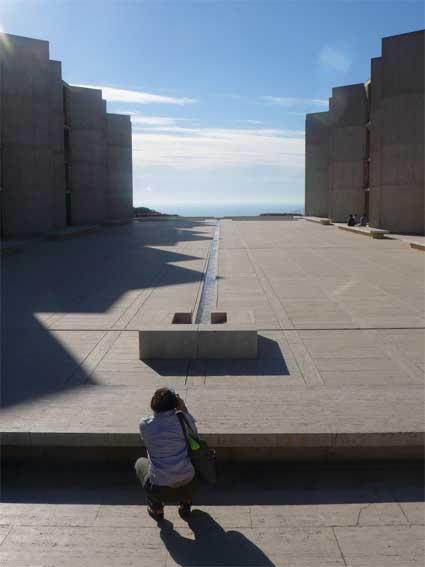
I find it hard to believe that no one has ever shot a movie there. Elio Petri would have done something amazing with this set.
Anyway, any solemn thought and sense of beauty we might have been filled with vanished half an hour after when we met with Mary Flanagan‘s Giant Joystick which is on view until March 17 in the art gallery in the Calit2 building at UCSD.
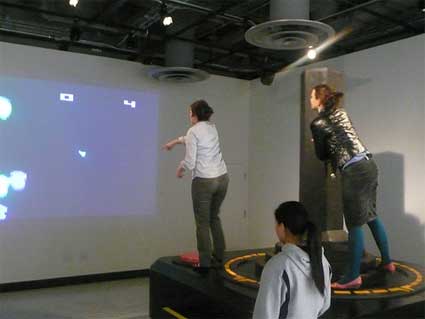
Extremely fun and physically exhausting.
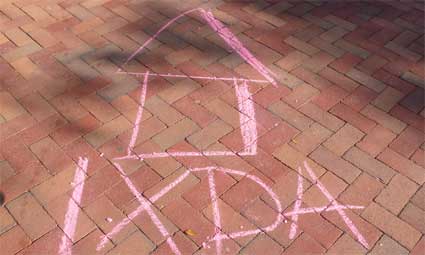
I’m just back from the IxDA Interaction 08 conference organized by the Savannah College of Art and Design in Savannah, Georgia. My favourite talk was Strategic Boredom by Molly or how two visionaries from the ’50s and ’60s could teach us something about introducing boredom into interaction.
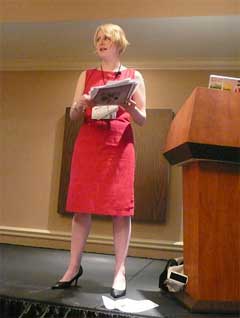 Molly Wright Steenson is a PHD student in architecture at Princeton University and an interaction designer.
Molly Wright Steenson is a PHD student in architecture at Princeton University and an interaction designer.
When i realized that Molly posted most of her talk on her new blog Conceptual Device, i thought i could just add it to my del.icio.us links but then it would be lost for most of my readers. So i’m going to let you read the intro on her site and take over with what i wrote down during her talk, from the moment when she focused on Gordon Pask and Cedric Price. Not sure it makes much sense but it does make me happy. This blog was born out of a need to archive what could serve my own enlightenment after all.
Martin Heidegger studied boredom in Fundamental Concepts of Metaphysics as part of his continual exploration of existence. At some point he suggested an interesting strategy when facing boredom: “not to resist straightaway but to let resonate… only by not being opposed to it, but letting it approach us and tell us what it wants, what is going on with it.”
The idea of exploring boredom took an interesting turn with cybernetics,
Louis Kauffman, President of the American Society for Cybernetics, defines cybernetics as “the study of systems and processes that interact with themselves and produce themselves from themselves”.
There is first order cybernetics (not much interaction here) and second order cybernetics (an organism or social system is an agent in its own right, interacting with another agent, the observer.)
Gordon Pask was interested in Second Order Cybernetic. Pask had a PHD in psychology and was particularly interested in learning and conversations.
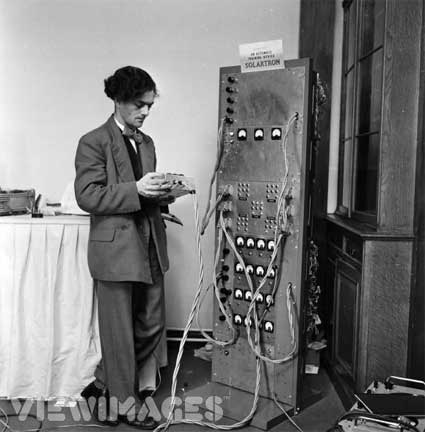
Gordon Pask (Photo by Harry Kerr/BIPs/Getty Images)
In 1953, Pask created the Musicolour machine. The machine was inspired by the concept of synesthesia and aimed at exploring what happens when music and light interact with each other. He’s the only one nor the first to work on such idea but what makes the Musicolour interesting is that Pask introduced the notion of boredom in the equation.
The work held a “conversation” with the performer. The musician would respond to visual queues, the machine in turn would build an understanding of what the musician was playing, and, when it detects that the musician is repeating a same sequence too often, the system would “get bored” and challenge the musician to find new ways to re-engage the system.
The idea of building upon boredom reappears with Cedric Price‘s Generator. Just like Archigram, Price didn’t build much but his radical ideas had a huge influence on contemporary architecture. At the core of Price’s practice was the belief that new technology could enable the public to gain control over their environment, resulting in a building which could be responsive to visitors’ needs and the many activities intended to take place there.
The Fun Palace, probably his most influential projects, was never realized but it nevertheless inspired the Centre Georges Pompidou that Richard Rogers and Renzo Piano built ten years later in Paris.

Fun Palace, an unrealised project for East London, 1960-1961
Price became also famous for his project of a mobile university on rails, the Potteries Thinkbelt (1965). He proposed the conversion of declining industrial zone into a huge High Tech think-tank, with mobile classrooms and laboratories mounted on the rail lines, moving from place to place, from housing to library to factory to computer center.

Plan for Potteries Thinkbelt, Staffordshire, England, 1965
Price was not interested in formalism but in conditions that would change people behaviour through their interaction with architecture.
The idea reappears in Price’s Generator (1976-79, not built). This series of cubes, screens, walkways and catwalks could be moved around by a mobile crane on the site to meet visitors’ needs and desires. Price’s collaborator John Frazer, proposed that the cubes be outfitted with sensors that would report on the use of the components. If the pieces of Generator weren’t moved enough, they would grow bored and design their own layouts, which in turn would be handed off to the mobile crane operator to put into place.
 In an interview with Hans Ulrich Obrist, Price declared:
In an interview with Hans Ulrich Obrist, Price declared:
In defining architecture, you don’t necessarily define the consumption of it. All the designs we did for Generator [Florida, 1966] were written as menus, and then we would draw the menu, and because I like bacon and eggs for breakfast, it was all related to that bit of bacon and that bit of egg. They were all drawn, however cartoon-like, in the same order – not in the order the chef or cook would arrange them on your plate, but in the order in which the consumer would eat them. And that is related to the consumption or usefulness of architecture, not to the dispenser of it.
Generator would also have the task to surprise its users. In collaboration with programmer-architects John and Julia Frazer, he imagined that each element of Generator would become “intelligent” by being outfitted with a microchip. The sensors would interact with four computer programs that performed a variety of tasks, including keeping inventory, aiding Generator’s users to design different layouts, and most powerfully and importantly, getting bored. The boredom routine would run if people did not request changes of Generator frequently enough, or if the parts were not aptly used. It would draw up new plans for Generator, which would be handed off to the social elements of the project.
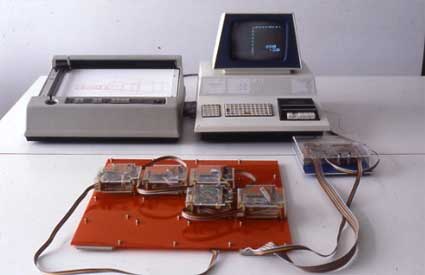
John and Julia Frazer, Generator Electronic Model
In the correspondence between Price and his system research consultants Julia & John Frazer, Molly encountered this thought-provoking sentence: “If you kick a system the very least you would expect is for them to kick you back.”
What interested Price was not to design the perfectly controlled system but to create a Generator which would make things that neither the architect nor the users expect, a system that gets involved and plays an active role once it gets bored. That was his idea of interaction: a troublesome system that bites back, that engages in a conversation and do things you wouldn’t have thought about, no matter how carefully you have devised that system.
Previously: Paskian Environments.
Today, as part of The Bilderberg’s Future_Brunch 101 salon at Transmediale, Francis Hunger gave a presentation about The Setun Conspiracy which received an Honorary Mention last night at the Transmediale ceremony (details about the winning projects in this press release PDF.)
And for whatever this is worth, it was my favourite work among the nominees…
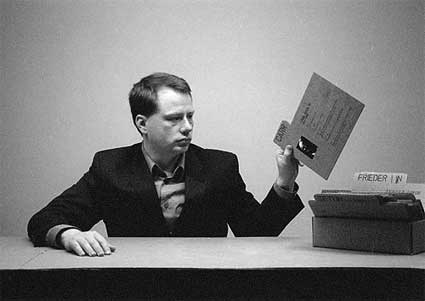
The SETUN computer was developed in 1958 by Nikolai Brusentsov and his team at the Moscow State University. SETUN is based on ternary logic (-1, 0, 1), which distinguishes it completely from the usually binary operating computers of the present and the past. While the binary logic just allows two states yes (1) | no (0), the ternary logic has three different logical states: yes (1) | no (-1) | both or maybe (0). Western computer scientists tried to create such a ternary computer in the following years but never succeeded.
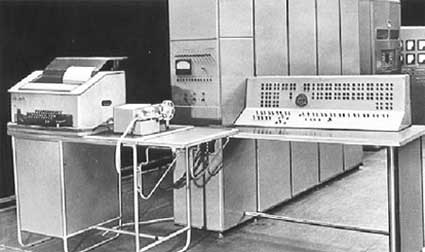
“Setun” trinary computer developed at Moscow University (image)
Francis Hunger’s work consists of several elements: the archive research collected since 2003, representation of the results in form of an office since 2005 and a book with essays and interviews, which is is just out from the printer*.
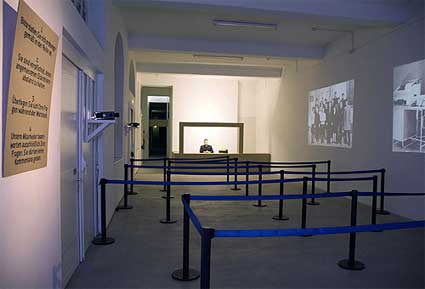
Installation view
The installation puts visitor in an office situation with a waiting line of rope and stanchions that lead to a cardboard office, reminding the high security places where human behaviour gets directed. The waiting line are meant to have visitors experience the whole space, getting to watch 2 images projected on the wall (one of the computer, another one of the team who developed it) and read the list of rules that instructs their behaviour: people are allowed to ask questions only, not to make comments; they should access from the right side; they should keep a discretion distance since it is an individual session with only one or maximum two persons allowed to come near the performer at the time. Any visitor who would not respect the rules will be dismissed.
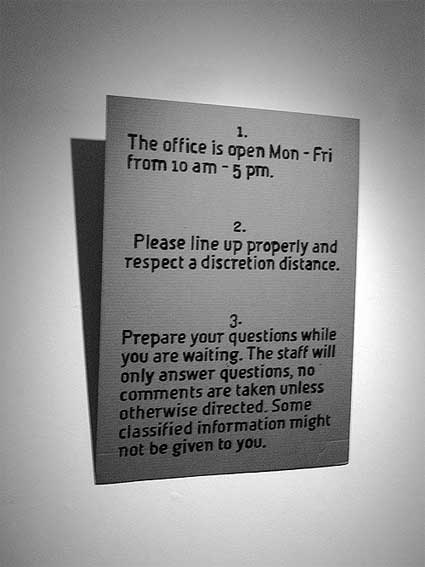
It is both a “discipline and punishment” situation but also a playful one.
After having done extensive research about Setun (exchanging emails with Nikolai Brusentsov, extensive readings and research for documents written about the computer, etc.), Francis’ concern was “What is the best way to distribute knowledge?” A text could of course transmit the knowledge but wouldn’t produce the same situation, that level of interactivity. Throughout the “interactive” performance Hunger is the only one who has the knowledge. If people ask the right questions they might discover whether the Setun conspiracy is a fact or a fiction.
Hunger than read a text that has influenced a lot his ideas about interactivity. It is a statement that Alexei Shulgin wrote11 years ago and which addresses the question of interactive art:
Looking at very popular media art form such as ‘interactive installation’ I always wonder how people (viewers) are excited about this new way of manipulation on them. It seems that manipulation is the only form of communication they know and can appreciate. They are happily following very few options given to them by artists: press left or right button, jump or sit. Their manipulators artists feel that and are using seduces of newest technologies (future now!) to involve people in their pseudo-interactive games obviously based on banal will for power. But what nice words you can hear around it: interaction, interface for self-expression, artificial intelligence, communication even. So, emergence of media art is characterised by transition from representation to manipulation.

The Setun was what was called at the time an “electronic calculation machine”. For Nikolai Brusentsov, the ternary system was the most logical solution. It also turned up that it allowed to build the machine using less units and it was much more reliable than other computers made at the time. 50 copies were manufactured which, again, was quite an achievement for the time. It was used for agricultural calculation, nuclear power plants, for teaching programming, etc.
Here’s some more info found on the Soviet Computing website: Unfortunately, after the Setun-70 project, Brusentsov’s lab was relocated from the Computer Center at Moscow University to a windowless attic in a student dormitory and was deprived of any serious support. The new university rector considered computer design a pseudo-science. Brusentsov’s original Setun computer, an experimental prototype that had faithfully worked for seventeen years, was barbarically destroyed and carted off to the dump. Brusentsov’s laboratory coworkers took the Setun-70 to their attic laboratory and used it as a basis for developing the Master Work Station – an educational computer system.
To this day, Brusentsov maintains that the trinary system is superior to binary.
The artist is actually not happy with the title of his work. The word conspiracy evokes two ideas, it also evokes the difference between telling History and telling a story. There are conspiracies that exists. For example, the conspiracy against President Allende in 73 which is now sustained by well-recognized facts and sources which can be named. And then there is conspiracy that supports ideologies and simplifies world views. In the performance, the word “conspiracy” is used to get people interested in the work.
One year before Setun, on October 4, 1957 Sputnik satellite went up which triggered the “Sputnik Shock” in the US. They suddenly getting interested and preoccupied by this success of Russian technology. The conspiracy that Hunger constructed was that the Russians didn’t want to show the Setun computer but the US tracked down and found a traitor ready to talk to them about the computer.
More info about the book:
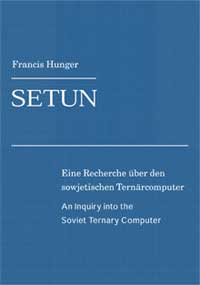 *SETUN. An Inquiry into the Soviet Ternary Computer. Eine Recherche über den Sowjetischen Ternärcomputer. Institut für Buchkunst Leipzig. German/ Englisch, ISBN 3-932865-48-0
*SETUN. An Inquiry into the Soviet Ternary Computer. Eine Recherche über den Sowjetischen Ternärcomputer. Institut für Buchkunst Leipzig. German/ Englisch, ISBN 3-932865-48-0
The work deals with the production and representation of knowledge, the historical and ideological aspects of technological development, and it aims to create an understanding of the intertwining of current technological and social developments using a historical perspective. The book makes original Russian sources available in English and German language and is accompanied by an original essay investigating into the relations between the “communist” Easts’ and capitalist Wests’ technological development. While the book aimes to provide a basis for further research, the artistic work tries to involve visitor and artist into what can not be expressed within the realm of theoretical discourse.